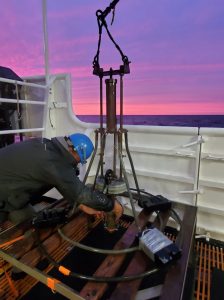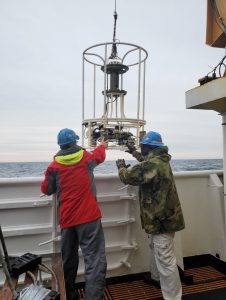
In the Gulf of Maine, seasonal forecasts of harmful algal bloom (HAB) severity depend on the numbers of seed-like HAB cells in the sediments, frequently called cysts. Cyst abundances are measured in the fall or early winter prior to the forecast release in the spring. In October 2019, a NCCOS-sponsored cyst cruise, in partnership with the Woods Hole Oceanographic Institution (WHOI), sailed aboard the NOAA Ship Gordon Gunter to document cyst abundance across the Gulf of Maine.
Gulf of Maine red tide, caused by Alexandrium catenella, produces a toxin that can accumulate in shellfish. Human consumers of toxin-contaminated shellfish can experience paralytic shellfish poisoning, a serious or even fatal illness. To protect human health, state agencies conduct rigorous monitoring and ban harvesting of toxic shellfish. NCCOS provides forecasts of Gulf of Maine red tide events that enable proactive responses to protect coastal economies, making the region more resilient to red tide outbreaks.

Alexandrium catenella seasonal forecasts depend on measurements of the abundance of the cysts in bottom sediments within the Gulf of Maine. From October 2-10, 2019, a NCCOS/WHOI crew sailed from Newport, RI, on the Gordon Gunter collecting and mapping A. catenella cyst abundance. Fifty-seven stations were sampled for sediment cyst abundance using a Carib Corer. Water column physical parameters were determined using a conductivity, temperature, and depth (CTD) instrument.
NCCOS participants in the 2019 cruise included Chief Scientist Teresa (Terry) McTigue, NCCOS Deputy Director Margo Schulze-Haugen, CRP Director David Kidwell, Steve Kibler, Yizhen Li, Andrew Meredith, Todd Neison, Mary Rider, Mary Kate Rogener, and NCCOS 2019 Knauss Sea Grant Fellow Alessandra (Ali) Burgos. WHOI participants included David Kulis. Students sponsored by the NOAA Educational Partnership Program included Elyse Bonner (Tuskegee University) and Prian Vidal (Florida A&M University).
For more information, contact terry.mctigue@noaa.gov.
